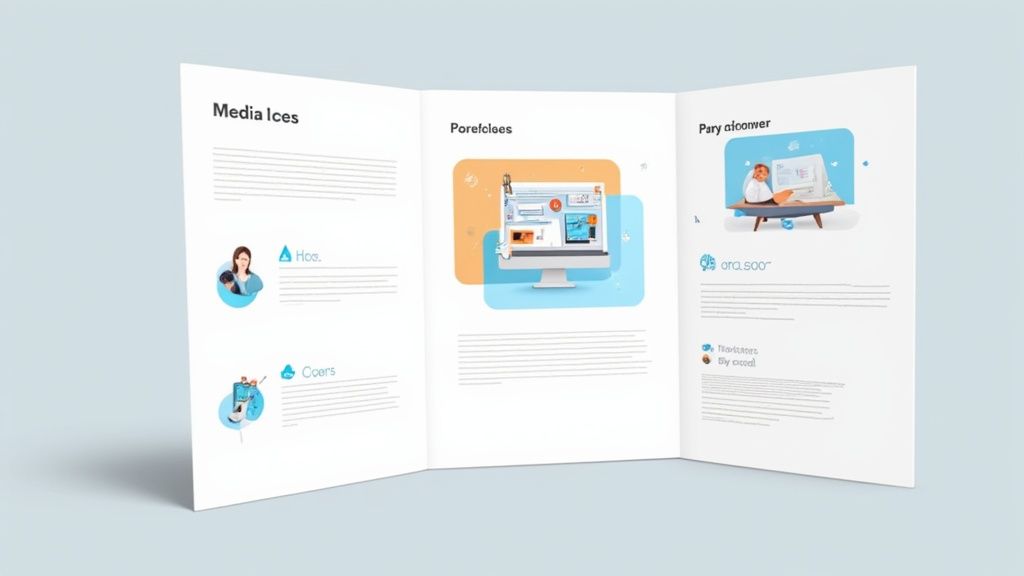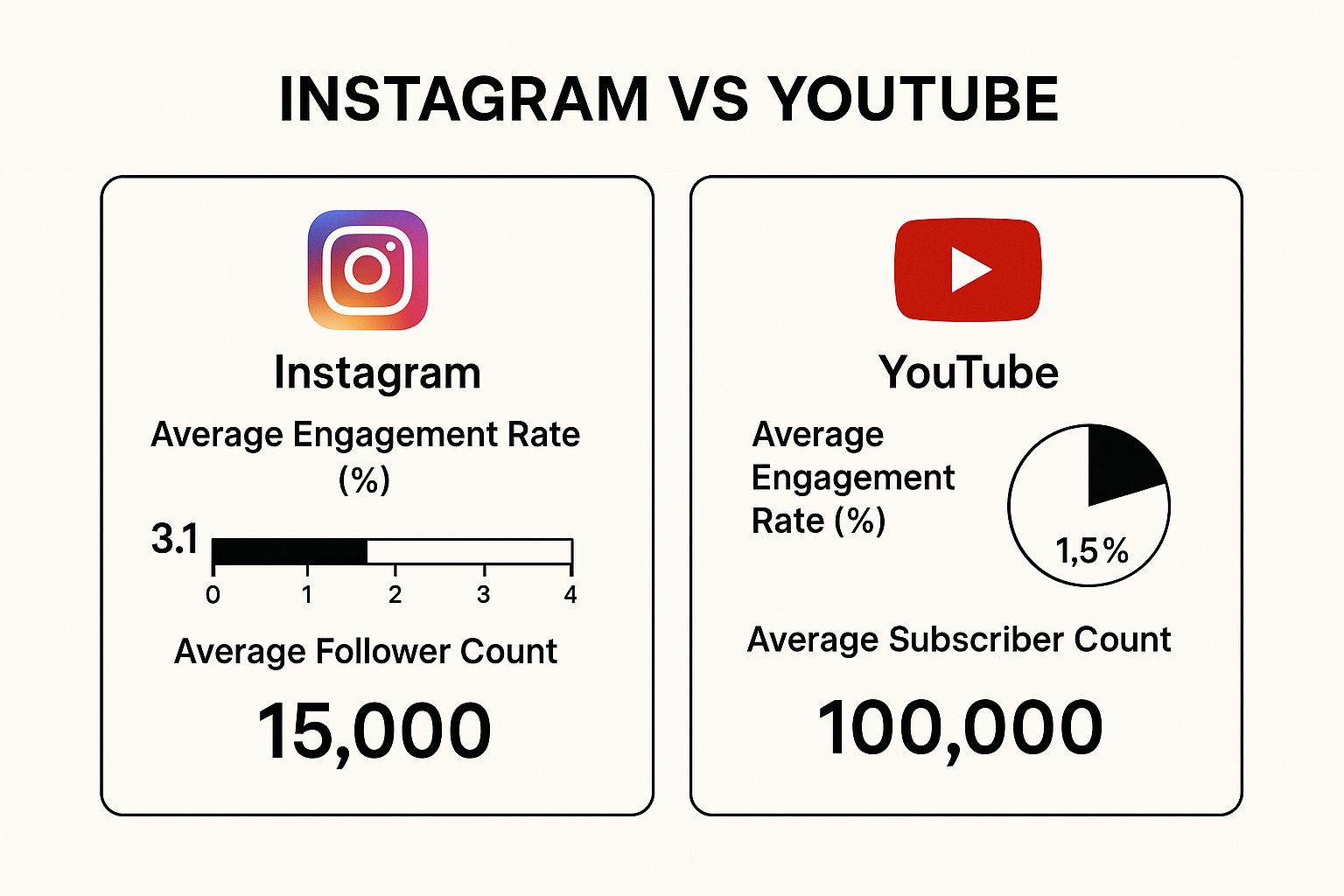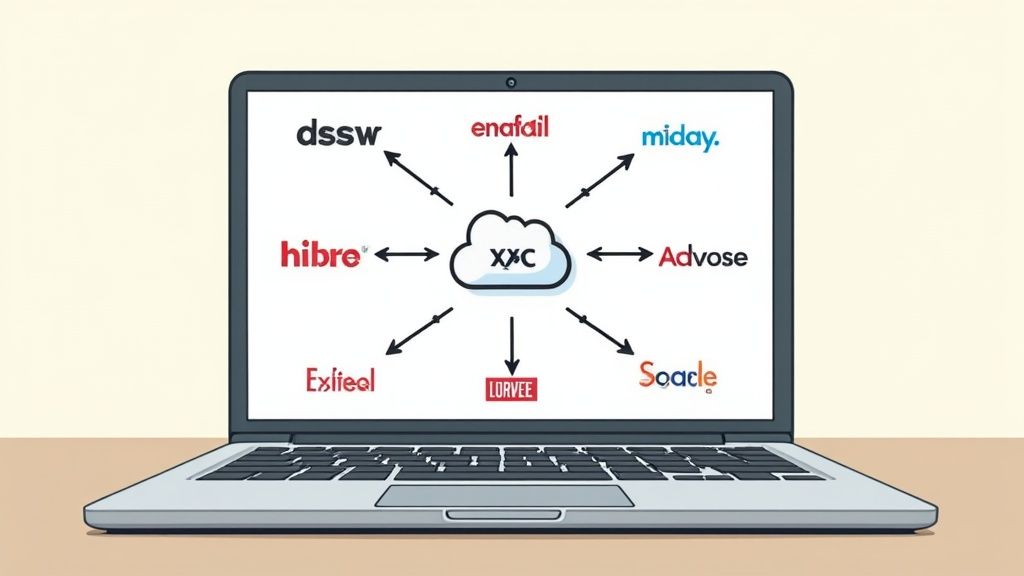Before you even think about sending that first pitch, you need to lay the groundwork. The truth is, securing brand deals isn’t about chasing companies—it’s about building something so compelling that companies want to chase you. It all starts with building an authentic brand and a community that genuinely trusts what you have to say.
Laying the Groundwork for Paid Partnerships

This is where the real work happens, long before you start reaching out. The foundation of a successful creator career is built on strategic positioning and trust, not just posting content whenever you feel like it.
A common mistake I see is creators getting obsessed with their follower count, thinking a big number is the golden ticket. But experienced brands know better. They’re digging deeper, looking for creators who have a tangible influence over a dedicated audience. This is where you need to stand out and prove your worth.
Define Your Unique Value and Niche
First things first: what makes you different? Who are you really talking to? If you can’t answer these questions clearly, brands won’t be able to either. Trying to be everything to everyone is a recipe for getting lost in the noise.
You have to get specific. A creator who focuses on “sustainable travel for solo female backpackers” is infinitely more appealing to the right brands than a generic “travel influencer.”
This laser focus does two crucial things:
- It helps you build a tight-knit community that hangs on your every word and trusts your recommendations.
- It makes you a no-brainer for brands in that space. They see you and immediately think, “That’s our person.”
Think of it this way: a small, die-hard following is way more valuable to a brand than a massive, indifferent one. Engagement and audience relevance are the currencies that actually matter in this game.
Imagine you’re a tech creator who zeroes in on budget-friendly home office setups for freelancers. Right away, brands selling ergonomic chairs, affordable monitors, or productivity software see a perfect match. Your niche isn’t a limitation; it’s your superpower.
Move Beyond Vanity Metrics
Follower count is just one piece of the puzzle, and frankly, it’s often the least interesting one. Savvy brands are looking at the data behind the profile to understand your true value. Your job is to make that value undeniable.
Start paying close attention to the metrics that actually signal influence:
- Engagement Rate: Are people commenting, sharing, and saving your posts? This proves your audience is paying attention. A high engagement rate on an account with 5,000 followers is often more impressive than a low one on an account with 100,000.
- Audience Demographics: Get to know your people. What are their ages, where do they live, and what are their interests? This is the data you’ll use to prove to a brand that you can connect them with their ideal customers.
- Click-Through Rate (CTR): When you drop a link in your bio or stories, do people click it? This is direct proof that you can inspire your audience to take action.
When you shift your content strategy to boost these specific numbers—not just your follower count—you send a powerful signal. You’re not just another creator. You’re a professional marketing partner who’s ready to do business.
Your Media Kit: The Key to Unlocking Brand Deals

Think of your media kit as your handshake, resume, and sales pitch all rolled into one. In the fast-paced world of brand partnerships, it’s often the only document a busy brand manager will glance at. It needs to grab their attention instantly and show them you’re the real deal.
This isn’t just a document listing your social handles; it’s a strategic tool. A great media kit anticipates a brand’s questions and provides compelling answers, showing them exactly why a partnership with you is a brilliant business decision.
The influencer marketing industry is now worth around $32.5 billion, and businesses are seeing an average return of $6.50 for every dollar they invest. This means brands aren’t just looking for exposure; they’re looking for partners who deliver results. Your media kit is your first, best chance to prove you’re that partner.
Building a Media Kit That Gets a “Yes”
A powerful media kit is clean, professional, and straight to the point. It should give a brand a clear picture of who you are, who you reach, and what you can do for them. Don’t just throw numbers at them—weave a narrative about the value you provide.
Here are the absolute essentials every media kit needs:
- A Punchy Bio: Forget the generic “About Me.” In just 2-3 sentences, capture your essence. What’s your niche? What’s your mission? What unique value do you bring to your community?
- Audience Demographics: This is critical. Brands need to see that your audience is their audience. Include key data like age ranges, gender breakdown, and top countries or cities.
- Core Performance Metrics: This is where you back up your claims. Showcase your average reach, impressions, and—most importantly—your engagement rate. A high engagement rate on a smaller, dedicated audience is often far more valuable than a huge, passive following.
- Proof of Past Success: Nothing speaks louder than results. Feature logos of brands you’ve worked with. If you can, include 1-2 mini-case studies with concrete outcomes. This social proof is incredibly persuasive.
Don’t Just Tell Them, Show Them: The Power of a Portfolio
Your media kit lays out the facts, but your portfolio brings your talent to life. It’s where you demonstrate your creative flair and the high quality of your work. A brand manager needs to see that you can create content that is not only engaging but also polished and professional.
A media kit provides the data, but a portfolio proves the artistry. The combination of the two makes it incredibly easy for a brand manager to envision a successful campaign with you.
Your portfolio is the visual evidence that you can deliver on your promises. It should be easily accessible from your media kit and carefully curated to highlight your best brand collaborations and standout organic posts.
Understanding what brands need is half the battle. They often communicate their vision through a creative brief. To get inside their heads, check out our guide on how to write a creative brief—it will give you a huge advantage by showing you exactly what they’re looking for.
When you present a professional, data-driven package like this, you remove the guesswork for brands and make saying “yes” to a partnership an easy decision.
How To Find and Pitch Brands You Admire
Let’s be honest: sitting around waiting for brand deals to magically appear in your inbox is a slow, frustrating game. The creators who are truly killing it are the ones out there making things happen. They’re actively seeking out partnerships with brands they already love and respect. It’s time to stop the “spray and pray” and start building a real strategy.
Mastering the art of landing brand deals starts with picking the right companies. Don’t just chase the biggest names you can think of. Instead, look at the products you already use and love. A pitch that comes from a place of genuine admiration is always going to be more powerful than one that doesn’t.
This breakdown shows a fascinating look at where creators are finding success on two of the biggest platforms.

What’s the takeaway here? While it might seem like YouTube creators have the larger follower counts, Instagrammers often pull in a higher average engagement rate. For brands, that engagement metric is pure gold.
Figuring Out Who to Actually Email
So, you’ve got your list of dream brands. Now what? The biggest mistake you can make is firing off your pitch to a generic info@brand.com email address. That’s a one-way ticket to the spam folder. Your mission is to find the actual human being who makes the decisions.
Your best friend in this hunt is LinkedIn. It’s the perfect place to do a little professional sleuthing. Start by searching for people at the company with job titles like:
- Influencer Marketing Manager
- Brand Partnerships Coordinator
- Social Media Manager
- PR Manager
These are the exact people whose job it is to find creators just like you. A personalized message that lands in the right inbox is a hundred times more effective than a cold email blast.
Remember, the goal isn’t just to send an email. It’s to start a conversation with the person who has the power to say “yes.” Taking a few extra minutes to find the right contact proves you’re a professional, not just another creator blasting out requests.
Don’t forget to check the brand’s website, too. Look for a “Press,” “Media,” or “Partnerships” page in the footer. You can often find direct contact information specifically for collaboration inquiries right there.
Crafting a Pitch That Gets a Reply
Brand managers are drowning in emails. I mean, completely swamped. If you want to stand out, your pitch has to be personal, straight to the point, and all about the value you can bring to them. Copy-and-paste templates are deleted in a heartbeat.
Think of your first email as a quick, impactful introduction. It needs to immediately answer three things for the brand manager:
- Who are you?
- Why are you a perfect fit for their brand?
- What’s your idea?
This isn’t the time for your life story. It’s about being concise and compelling. I’ve found a simple structure that really works.
First, personalize your opening. Mention a specific product you love or a recent campaign of theirs that you admired. This immediately shows you’ve done your homework.
Next, give a quick intro. One or two sentences about who you are and what your content is about. This is the perfect spot to attach your media kit so they can see all your stats and past work at a glance.
Then comes the most important part: the “why.” This is where you connect the dots for them. Explain the natural overlap between your audience and their ideal customer. Show them it’s a perfect match.
Finally, offer up a simple, tangible idea. Something like, “I’d love to feature your new hiking boots in a dedicated Instagram Reel on my upcoming trip to Yosemite.” It’s concrete and easy for them to visualize. End with a clear call to action, like a simple question: “Is this something you’d be open to discussing?”
This focused approach shows you mean business and dramatically increases your chances of getting the partnerships you’ve been dreaming of.
Negotiating Rates and Contracts with Confidence

Getting a “yes” from a brand you love is a huge win. But the conversations that come next are where you truly define your worth. Talking money and contracts can feel daunting, especially when you’re starting out, but this is the moment you transition from being a creator to a real business partner.
Confidence here isn’t about being aggressive; it’s about being prepared. You need to walk into that conversation knowing exactly what you’re worth, with the data to back it up. We’re not just pulling numbers from thin air. We’re building a solid case for why you deserve fair compensation for the value you deliver.
Setting Your Rates Based on Real Value
Let’s be clear: your follower count is a starting point, not the whole story. To get paid what you’re worth, you have to price your services based on what you’re actually bringing to the table.
Think beyond a single flat fee. You’re offering a suite of services, and each one has a different value.
- Content Type and Complexity: A quick Instagram Story is a world away from a professionally shot and edited YouTube deep-dive. Price each deliverable based on the production time, skill, and resources it demands.
- Engagement Metrics: A sky-high engagement rate is gold. It proves your audience isn’t just scrolling past—they’re listening and taking action. Brands will pay a premium for a creator who can spark real conversation.
- Audience Demographics: If your audience is a brand’s dream customer, you’re offering them a direct pipeline. That’s incredibly valuable and should be reflected in your price.
- Usage and Exclusivity Rights: This is a big one. Is the brand going to run your content as an ad? Are they asking you not to work with any competitors? Both of these things should come with a significant price bump, because they’re getting more value and you’re limiting your own earning potential.
It’s also smart to stay on top of what’s happening in the industry. For example, data shows that while female creators make up a huge part of the market, male creators often earn more per post. Knowing these kinds of details, like those in this 2025 influencer marketing report, helps you advocate for fair pay based on your specific value.
Decoding the Contract Red Flags
A contract isn’t just a formality; it’s the rulebook for your entire partnership. Skimming it or ignoring confusing clauses can cause serious headaches later on.
Never, ever sign a contract you don’t fully understand. It’s your job to protect yourself, your content, and your income. If a clause seems off, you have to speak up.
Keep an eye out for these common contract traps:
| Clause to Scrutinize | What to Look For | Why It Matters |
|---|---|---|
| Content Ownership | Watch for phrases like “in perpetuity” or “all rights.” | This could give the brand ownership of your work forever, to use however they want without paying you again. Push for limited-term usage rights. |
| Exclusivity | Vague or extremely long exclusivity periods. | A broad exclusivity clause can stop you from working with other brands—even ones that aren’t direct competitors—for an unreasonable amount of time. |
| Payment Schedule | Unclear terms or long delays like Net 60 or Net 90. | Your contract needs to spell out when and how you get paid. A standard and fair approach is 50% upfront and the rest on completion. |
Negotiating these points isn’t just about protecting yourself—it builds a foundation of respect. Brands that want to boost their influencer marketing ROI know that strong, equitable partnerships are key. By handling negotiations with clarity and confidence, you not only get paid fairly but also pave the way for a great long-term collaboration.
Turning One-Off Deals Into Long-Term Partnerships
Landing a brand deal is great. But the real goal? Turning that single project into a steady, long-term partnership. The creators who build sustainable careers aren’t constantly chasing the next new deal; they’re busy nurturing the relationships they already have, creating reliable, recurring income. This is all about playing the long game.
Your performance during and after the campaign is what sets you apart. It all boils down to one simple, yet powerful, mindset: always aim to over-deliver. This doesn’t mean working for free or doubling your deliverables. It means going above and beyond in your communication, professionalism, and the quality of your work. You want to make the entire experience so smooth and impressive that they can’t wait to work with you again.
This strategy is more important now than ever. In fact, a recent influencer marketing benchmark report found that by 2025, about 63.8% of brands plan to work with influencers, and many are specifically looking for long-term collaborators. Brands are moving away from one-off campaigns, which is a huge opportunity for creators who can prove their long-term value.
Provide Actionable Post-Campaign Insights
Don’t make the mistake of disappearing once your content goes live. So many creators just send over the live link and call it a day. That’s a massive missed opportunity. If you really want to stand out, follow up with a brief, insightful post-campaign report about a week or two after everything is done.
This isn’t just about sending a spreadsheet of numbers. You need to tell the story of the campaign’s success.
- Key Performance Metrics: Go beyond the basics. Grab screenshots of your reach, impressions, engagement rate, and any link clicks.
- Audience Sentiment: Hand-pick a few of the most positive, insightful comments from your community. This kind of qualitative feedback is pure gold for a brand manager.
- Your Personal Takeaways: Offer a sentence or two explaining what you think resonated most with your audience and why the campaign was a hit from your perspective.
This simple gesture shows you’re not just a hired gun; you’re a strategic partner who is genuinely invested in their success.
By providing a clear summary of the results, you are making the brand manager’s job easier. You’re giving them the exact data they need to justify working with you again to their team.
Nurture the Relationship Proactively
The final piece of the puzzle is to keep the connection going long after the final payment has cleared. You want to be the first person they think of when their next campaign idea pops up. The key is staying on their radar in a way that feels authentic, not annoying.
For example, did you see people in your comments still raving about the product weeks later? Screenshot it and send it over in a quick email. This demonstrates the lasting value you brought.
You can also be proactive about future ideas. A simple message like, “Hey! I have a fun idea for a holiday-themed post with your new product line. Just wanted to put it on your radar as you start planning for Q4,” can easily spark another collaboration.
This long-term thinking is what separates hobbyists from professionals. These strategies help make your personal brand more memorable and trustworthy, which is a core part of how to improve your brand awareness with future partners. When you become a reliable, forward-thinking partner, you stop chasing gigs and start building a real career.
Common Questions About Securing Brand Deals
Diving into the world of brand partnerships often brings up a lot of questions. It can feel like you’re trying to crack a code. As you start reaching out and trying to land your first deals, you’ll almost certainly run into the same roadblocks that every creator faces.
Let’s clear up some of the most common points of confusion. Getting a handle on these now will save you a ton of headaches and help you approach brands with more confidence.
How Many Followers Do I Really Need?
This is, without a doubt, the question I hear most often. The answer is probably not what you think, and it’s good news: it’s much less about your follower count and far more about your engagement.
Brands have gotten smarter. They now recognize the immense power of nano-influencers (those with under 10,000 followers) who have cultivated a tight-knit, highly engaged community. A smaller audience that genuinely trusts what you say is infinitely more valuable to a brand than a huge, indifferent one. So, stop obsessing over the number and start pouring your energy into building a real community and sparking conversations.
The old myth that you need 100,000 followers is officially dead. A creator with 5,000 loyal followers in a specific niche like “vegan skincare” can be a goldmine for the right beauty brand—often more effective than a general lifestyle creator with ten times the audience.
Should I Work for Free Products?
When you’re just getting your feet wet, accepting a product-only deal (sometimes called “in-kind”) can be a strategic first step. It’s a great way to get some real-world experience, build up your portfolio, and prove you can deliver results for a brand.
But think of this as a temporary phase. Your goal should be to quickly transition to paid collaborations as you gain more experience. Don’t forget, your time, your creative energy, and the direct line you provide to your audience all have real monetary value.
Before you say yes to a product-only deal, always weigh the value of the item against the amount of work you’re being asked to do.
- A high-value item that you genuinely need and that fits your content perfectly (like a new camera or specialized software) could be a fair trade for a detailed review.
- A low-value product that requires a multi-post campaign with stories and a dedicated video? That’s not a good deal. Your creative effort in that scenario absolutely deserves to be paid.
What if a Brand Ignores My Pitch?
First things first: don’t take it personally. Seriously. Brand managers are swimming in emails, often receiving hundreds of pitches a day. It’s incredibly easy for a great pitch to get buried or accidentally overlooked.
Sending a polite follow-up email is standard professional practice. Wait about a week after your initial email, then send a short, friendly message to bump your original pitch back to the top of their inbox.
If you still get radio silence after that, it’s time to let it go and move on. Keep a simple spreadsheet of who you’ve contacted and when. You can always try pitching them again in a few months, especially if you have new audience growth or exciting project results to share. Persistence is key, but knowing when to redirect your energy is even more important.
Navigating brand deals, from the first email to building lasting partnerships, is all about having the right strategy. At ReachLabs.ai, we specialize in connecting talented creators with brands that are a perfect fit for their voice, helping you turn your passion into a real business. Learn how we can help you secure your next brand deal.





